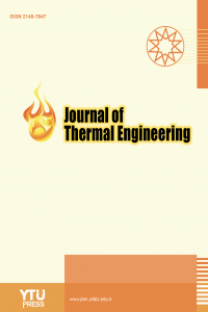PARTICIPATING MEDIA FOR VOLUMETRIC HEAT GENERATION
Participating Media Volumetric Heat Generation,
___
- [1] Duffie J. A. and Beckman W. A. (1991). Solar Engineering of Thermal Processes, 2nd edition, John Wiley & Sons, New York.
- [2] Green M. A. (1981). Solar Cells: Operation Principles, Technology, and System Applications, Prentice Hall, Englewood Cliffs, NJ.
- [3] Choi C., Yoo H. S. and Oh J. M. (2008). Preparation and heat transfer properties of nanoparticle-in-transformer oil dispersions as advanced energy-efficient coolants, Current Applied Physics 8 710-712.
- [4] Luo, Z., Wang, C., Wei, W., Xiao, G., & Ni, M. (2014). Performance improvement of a nanofluid solar collector based on direct absorption collection (DAC) concepts. International Journal of Heat and Mass Transfer, 75, 262-271.
- [5] Myers, D. (1999). Wetting and spreading. In Surfaces, interfaces and colloids. Principles and applications (pp. 415-447). John Wiley & Sons, New York.
- [6] Kozan, M., Thangala, J., Bogale, R., Mengüç, M. P., & Sunkara, M. K. (2008). In-situ characterization of dispersion stability of WO3 nanoparticles and nanowires. Journal of Nanoparticle Research, 10(4), 599-612.
- [7] Mischenko, M. I., Wiscombe, W. J., Hovenier, J. W., & Travis, L. D. (2000). Overview of scattering by nonsperical particles.
- [8] Du, M., & Tang, G. H. (2015). Optical property of nanofluids with particle agglomeration. Solar Energy, 122, 864-872.
- [9] Tyagi, H., Phelan, P., & Prasher, R. (2009). Predicted efficiency of a low-temperature nanofluid-based direct absorption solar collector. Journal of solar energy engineering, 131(4), 041004.
- [10] Said, Z., Sajid, M. H., Saidur, R., Mahdiraji, G. A., & Rahim, N. A. (2015). Evaluating the optical properties of TiO2 nanofluid for a direct absorption solar collector. Numerical Heat Transfer, Part A: Applications, 67(9), 1010-1027.
- [11] Milanese, M., Colangelo, G., Cretì, A., Lomascolo, M., Iacobazzi, F., & De Risi, A. (2016). Optical absorption measurements of oxide nanoparticles for application as nanofluid in direct absorption solar power systems–Part I: water-based nanofluids behavior. Solar Energy Materials and Solar Cells, 147, 315-320.
- [12] Milanese, M., Colangelo, G., Cretì, A., Lomascolo, M., Iacobazzi, F., & De Risi, A. (2016). Optical absorption measurements of oxide nanoparticles for application as nanofluid in direct absorption solar power systems–Part II: ZnO, CeO2, Fe2O3 nanoparticles behavior. Solar Energy Materials and Solar Cells, 147, 321-326.
- [13] Goutam, S., & Paul, M. C. (2014). Discrete phase approach for nanofluids flow in pipe.
- [14] Diggs, A., & Balachandar, S. (2016). Evaluation of methods for calculating volume fraction in Eulerian-Lagrangian multiphase flow simulations. Journal of Computational Physics, 313, 775-798.
- [15] Modest M. F., “Radiative Heat Transfer”, Academic Press-Elsevier science”, USA, 2003.
- [16] Howell, J. R., Menguc, M. P., & Siegel, R. (2015). Thermal radiation heat transfer. CRC press.
- [17] Fan, L. S., & Zhu, C. (1998). Principles of Gas-Solid Flows, Cambridge Series in Chemical Engineering. Cambridge University Press, United Kingdom.
- [18] Otanicar, T., Taylor, R. A., Phelan, P. E., & Prasher, R. (2009, January). Impact of size and scattering mode on the optimal solar absorbing nanofluid. In ASME 2009 3rd International Conference on Energy Sustainability collocated with the Heat Transfer and InterPACK09 Conferences. American Society of Mechanical Engineers, 791-796.
- Yayın Aralığı: 6
- Başlangıç: 2015
- Yayıncı: YILDIZ TEKNİK ÜNİVERSİTESİ
A CFD INVESTIGATION OF Al 2 O 3 /WATER FLOW IN A DUCT HAVING BACKWARD-FACING STEP
K. ARSLAN, R. EKİCİLER, E. AYDENİZ
Avinash M. DESHMUKH, S. N. SAPALİ
M. OZDOGAN, L. NAMLİ, A. DURMUS
Onur BOR, Muhammed Murat AKSOY, Önder KAŞKA, Nehir TOKGÖZ
F. SELİMEFENDİGİL, T. BİNGÖLBALI
